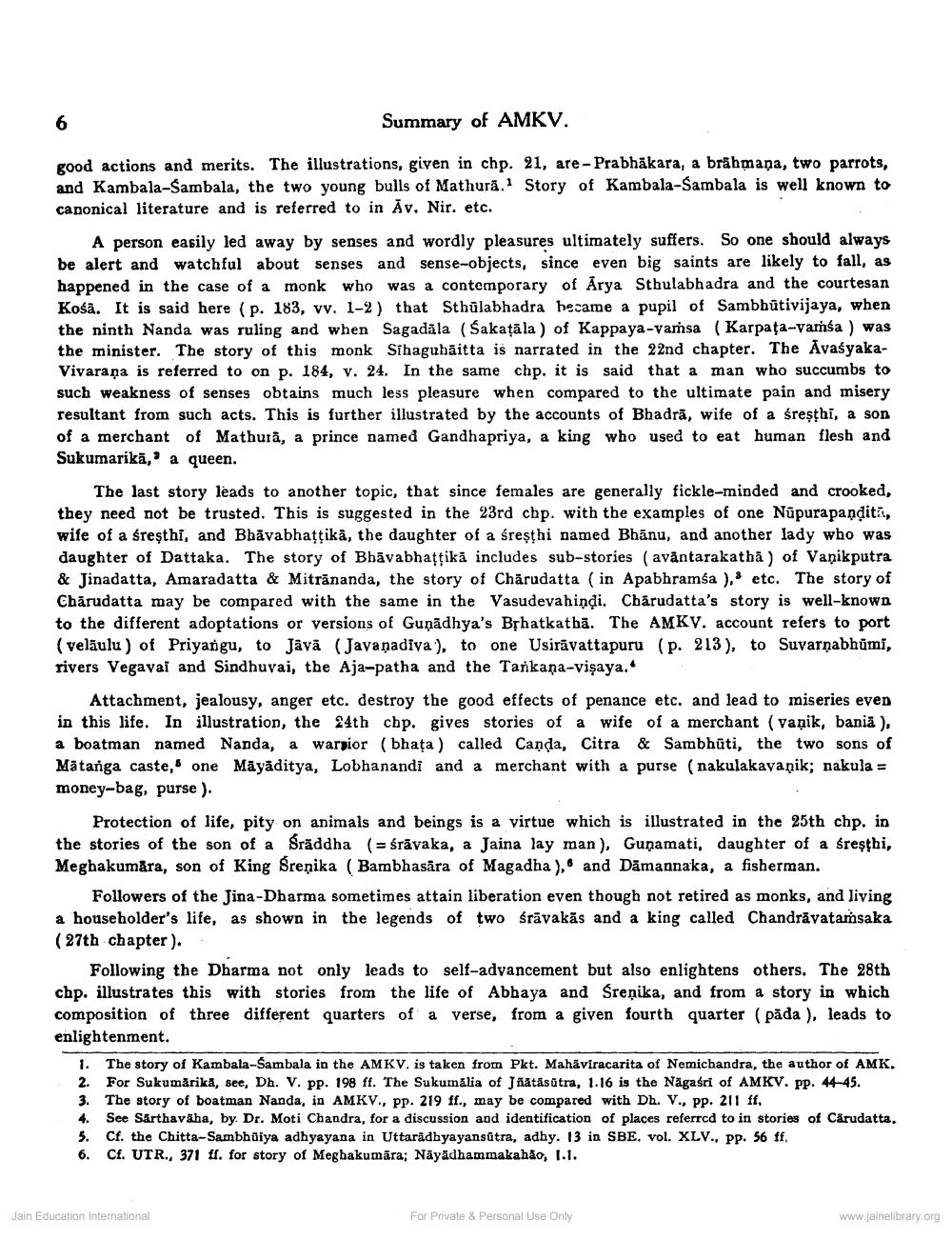________________
Summary of AMKV.
good actions and merits. The illustrations, given in chp. 21, are - Prabhākara, a brāhmaṇa, two parrots, and Kambala-Sambala, the two young bulls of Mathura. 1 Story of Kambala-Sambala is well known to canonical literature and is referred to in Av. Nir. etc.
A person easily led away by senses and wordly pleasures ultimately suffers. So one should always be alert and watchful about senses and sense-objects, since even big saints are likely to fall, as happened in the case of a monk who was a contemporary of Arya Sthulabhadra and the courtesan Kośā. It is said here (p. 183, vv. 1-2) that Sthūlabhadra became a pupil of Sambhütivijaya, when the ninth Nanda was ruling and when Sagadāla (Sakațāla) of Kappaya-vaṁsa (Karpaţa-vamsa) was the minister. The story of this monk Sihaguhāitta is narrated in the 22nd chapter. The AvaśyakaVivarana is referred to on p. 184, v. 24. In the same chp. it is said that a man who succumbs to such weakness of senses obtains much less pleasure when compared to the ultimate pain and misery resultant from such acts. This is further illustrated by the accounts of Bhadrā, wife of a śreşthi, a son of a merchant of Mathura, a prince named Gandhapriya, a king who used to eat human flesh and Sukumarikā,' a queen.
The last story leads to another topic, that since females are generally fickle-minded and crooked, they need not be trusted. This is suggested in the 23rd cbp. with the examples of one Nūpurapandita, wife of a śreşthi, and Bhavabhațţikā, the daughter of a śreșthi named Bhānu, and another lady who was daughter of Dattaka. The story of Bhāvabhațţiká includes sub-stories (aväntarakatha) of Vaņikputra & Jinadatta, Amaradatta & Mitrānanda, the story of Chārudatta (in Apabhramśa ),' etc. The story of Chārudatta may be compared with the same in the Vasudevahiņdi. Chārudatta's story is well-known to the different adoptations or versions of Guņādhya's Bphatkathā. The AMKV. account refers to port (velāulu ) of Priyangu, to Jāvā (Javaņadiya), to one Usirāvattapuru (p. 213), to Suvarnabhumi, rivers Vegavai and Sindhuvai, the Aja-patha and the Tarkaņa-vişaya.
Attachment, jealousy, anger etc. destroy the good effects of penance etc. and lead to miseries even in this life. In illustration, the 24th chp. gives stories of a wife of a merchant (vaņik, bania ), a boatman named Nanda, a warsior (bhata ) called Cança, Citra & Sambhūti, the two sons of Mātanga caste, one Māyāditya, Lobhanandi and a merchant with a purse (nakulakayanik; nakula = money-bag, purse ).
Protection of life, pity on animals and beings is a virtue which is illustrated in the 25th chp. in the stories of the son of a Sräddha (= śrāyaka, a Jaina lay man), Gunamati, daughter of a freşthi, Meghakumara, son of King Srenika ( Bambhasära of Magadha ), and Dāmannaka, a fisherman.
Followers of the Jina-Dharma sometimes attain liberation even though not retired as monks, and living a householder's life, as shown in the legends of two śrāvakās and a king called Chandrāvatamsaka (27th chapter ).
Following the Dharma not only leads to self-advancement but also enlightens others. The 28th chp. illustrates this with stories from the life of Abhaya and Sreņika, and from a story in which composition of three different quarters of a verse, from a given fourth quarter (pāda ), leads to enlightenment.
1. The story of Kambala-Sambala in the AMKV. is taken from Pkt. Mahaviracarita of Nemichandra, the author of AMK. 2. For Sukumärika, sec, Dh. V. pp. 198 ff. The Sukumália of Jñātāsūtra, 1.16 is the Nāgaści of AMKV. pp. 44-45. 3. The story of boatman Nanda, in AMKV., PP. 219 ff., may be compared with Dh. V., pp. 211 ff. 4. See Sárthaväha, by. Dr. Moti Chandra, for a discussion and identification of places referred to in stories of Cärudatta. 5. Cf. the Chitta-Sambhūiya adhyayana in Uttaradhyayansútra, adhy. 13 in SBE, vol. XLV., PP. 56 ff. 6. Cf. UTR., 371 . for story of Meghakumāra; Nayadhammakahão, 1.1.
Jain Education International
For Private & Personal Use Only
www.jainelibrary.org




